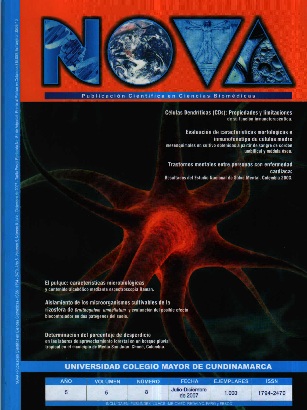Células madre mesenquimales: características biológicas y aplicaciones clínicas.
Células madre mesenquimales: características biológicas y aplicaciones clínicas.

NOVA por http://www.unicolmayor.edu.co/publicaciones/index.php/nova se distribuye bajo una Licencia Creative Commons Atribución-NoComercial-SinDerivar 4.0 Internacional.
Así mismo, los autores mantienen sus derechos de propiedad intelectual sobre los artículos.
Mostrar biografía de los autores
Las células madre mesenquimales son células pluripotentes y adultas con morfología fibroblastoide y plasticidad hacia diversos linajes celulares como condrocitos, osteocitos y adipocitos entre otros. Estas células pueden ser aisladas principalmente de médula ósea, sangre de cordón umbilical y tejido adiposo de donde se han logrado establecer cultivos que han permitido estudiar sus propiedades funcionales y fenotípicas.
Aunque la información obtenida hasta la fecha no brinda un conocimiento completo, se espera que con el desarrollo de próximas investigaciones se aclaren diversos aspectos biológicos para implementar su uso en medicina regenerativa. Esta revisión presenta una visión general sobre las células madre mesenquimales: morfología e inmunofenotipo, ontogenia, fuentes de obtención y aplicaciones clínicas.
Visitas del artículo 6708 | Visitas PDF 3024
Descargas
- Friedenstein AJ, Deriglasova UF, Kulagina NN, Panasuk AF, Rudakowa S, Lueria E. Precursors for fibroblasts in different populations of hematopoietic cells as detected by the in vitro colony assay method. Exp Hematol. 1974;2:83 -92.
- Beyer N, Da Silva L. Mesenchymal Stem Cells: Isolation in vitro Expansion and Characterization. Handb Exp Pharmacol. 2006;174:249-282.
- Krampera M, Pizzolo G, Aprili G, Franchini M. Mesenchymal Stem Cells for bone, cartilage, tendon and skeletal repair. Bone. 2006;39:678-683
- Chang Y, Tseng C, Hsu L, Hsieh T, Hwang S. Characterization of two populations of mesenchymal progenitor cells in umbilical cord blood. Cell Biol Int. 2006;30:495-499.
- Dominici M, Le Blanc K, Mueller I, Staper Cortenbach I, Marini F, Krause D et al. Minimal criteria for defining multipotent mesenchymal stromal cells. The International Society for Cellular Therapy position statement. Cytotherapy. 2006; 8:315-317
- Bianco P, Riminucci M, Gronthos S, Robey P. Bone Marrow Stromal Cells: Nature, Biology, and Potencial Applications. Stem Cells. 2001;19:180-192.
- Rasmusson I. Immune modulation by mesenchymal stem cells. Exp Cell Res. 2006;312:2169-2179.
- Deans RJ, Moseley AB. Mesenchymal Stem Cells: Biology and potential clinical uses. Exp Hematol. 2000;28:875-884.
- Lakshmipathy U, Verfaille C. Stem Cell Plasticity. Blood Rev. 2005; 19:29-38.
- Rodriguez V. Células Madre: Conceptos Generales y Perspectivas de Investigación. Universitas Scientiarum. 2005;10:5-14.
- Muraglia A, Cancedda R, Quarto R. Clonogenic mesenchymal progenitors from human bone marrow differentiate in vitro according to a hierarchical model. J Cell Sci. 2000;113:1161-1166.
- Erices A, Conget P, Minguell J. Mesenchymal progenitor cells in human umbilical cord blood. Br J Haematol. 2000;109:235-242.
- Airas L, Niemelä J, Salmi M, Puurunen T, Smith DJ, Jalkanen S. Differential Regulation and Function of CD73, a Glycosyl-Phosphatidylinositol–linked 70-kD Adhesion Molecule, on Lymphocytes and Endothelial Cells. J Cell Biol. 1997; 136:421-431.
- Sträter N. Ecto- 5’-nucleotidase: Structure function relationships. Purinergic Signal. 2006;2:343-350.
- Craig W, Kay R, Cutler RL, Landsorp PM. Expression of Thy-1 on Human Hematopoietic Progenitor Cells. J Exp Med. 1993;177:1331-1342.
- Barboni E, Rivero BP, George AJ, Martin SR, Renoup DV, Hounsell EF et al. The glycophosphatidylinositol anchor affects the conformation of Thy-1 protein. J Cell Sci. 1995;108:487-497.
- Wiesmann A, Buhring HJ, Mentrup C, Wiesmann HP. Decreased CD90 expression in human mesenchymal stem cells by applying mechanical stimulation. Head Face Med. 2006;31:2-8.
- Cheifetz S, Bellon T, Cales C, Vera S, Bernabeu C, Massagué J, Letarte. Endoglin is a Component of the Transforming Growth Factor –â Receptor System in Human Endothelial Cells. J Biol Chem. 1992; 67:19027-19030.
- Fonsatti E, Maio M. Highlights on endoglin (CD105): from basic findings towards clinical applications in human cancer. J Transl Med. 2004;2:18-24.
- Roura S, Farre J, Soler-Botija C, Llach A, Hove-Madsen L, Cairo JJ et al. Effect of aging on the pluripotential capacity of human CD105 (+) mesenchymal stem cells. Eur J Heart Fail. 2006;8:555-8563.
- Simmons PJ, Torok-Storb B. Identification of Stromal Cell Precursors in Human Bone Marrow by a Novel Monoclonal Antibody STRO-1. Blood. 1991; 8:55-62.
- Gonçalves R, da Silva C, Cabra J, Zanjani E, Almeida-Porada G. STRO-1+ human universal stromal feeder layer to expand/maintain human bone marrow hematopoietic stem/progenitor cells in a serum-free culture system. Exp Hematol. 2006;34:1353-1359.
- Lesley J, Hyman R, Kincade PW. Hyaluronan binding by cell surface CD44. J Biol Chem. 2000; 275:26967-26975.
- Zhu H, Mitsuhashi N, Klein A, Barsky L, Weinberg K, Barr M et al. The Role of the Hyaluronan Receptor CD44 in Mesenchymal Stem Cell Migration in the Extracellular Matrix. Stem Cells. 2006;24:928-935.
- Ohneda O, Ohneda K, Arai F, Lee J, Miyamoto T, Fukushima Y et al. ALCAM (CD166): Its Role in Hematopoietic and Endotelial Development. Blood. 2001; 98:2134-2142.
- R. Dorotkaa, U. Windbergerb, K. Macfeldab, U. Bindreitera, C. Tomaa, S. Nehrera. Repair of articular cartilage defects treated by microfracture and a three-dimensional collagen matrix. Biomaterials. 2005; 26:3617-3629.
- Guo L, Kawazoe N, Fan Y, Ito Y, Tanaka J, Tateishi T et al. Chondrogenic differentiation of human mesenchymal stem cells on photoreactive polymer-modified surfaces. Biomaterials. 2008;29:23-32.
- Kim J, Lee Y, Kim H, Hwang KJ, Kwon HC, Kim SK et al. Human amniotic fluid-derived stem cells have characteristics of multipotent stem cells. Cell Prolif. 2007;40:75-90.
- Mendes S, Robin C, Dzierzak E. Mesenchymal progenitor cells localize within hematopoietic sites throughout ontogeny. Development. 2005;132:1127-1136.
- Wexler S, Donaldson C, Denning P, Rice C, Bradley B, Hows J. Adult bone marrow is a rich source of human mesenchymal «stem» cells but umbilical cord and mobilized adult blood are not. Br J Haematol. 2003;121:368-374.
- Baksh D, Song L, Tuan RS. Adult mesenchymal stem cells: characterization, differentiation, and application in cell and gene therapy. J Cel Mol Med. 2004; 8:301-316.
- Wagner W, Wein F, Seckinger A, Frankhauser M, Wirkner U, Krause U et al. Comparative characteristics of mesenchymal stem cells from human bone marrow, adipose tissue, and umbilical cord blood. Exp Hematol. 2005;33:1402-1416.
- Kern S, Eichler H, Stoeve J, Klüter H, Bieback K. Comparative Analysis of Mesenchymal Stem Cells from Bone Marrow, Umbilical Cord Blood, or Adipose Tissue. Stem Cells. 2006;24:1294-1301.
- Bieback K, Kern S, Klüter H, Eichler H. Critical parameters for the isolation of mesenchymal stem cells from umbilical cord blood. Stem Cells. 2004;22: 625-634.
- Sabatini F, Petecchia L, Tavian M, Jodon V, Rossi GA, Brouty-Boye D. Human bronchial fibroblast exhibit a mesenchymal stem cell phenotype and multilineage differentiating potentialities. Lab Invest. 2005; 85:962-971.
- Shi S, Bartold PM, Miura M, Seo BM, Robey PG, Gronthos S. The efficacy of mesenchymal stem cells to regenerate and repair dental structures. Orthod Craniofac Res. 2005; 8:191-199.
- Lee RH, Kim B, Choi I. Characterization and expression analysis of mesenchymal stem cells from human bone marrow and adipose tissue. Cell Physiol Biochem. 2004;14:311-324.
- Krampera M, Pasini A, Pizzolo G, Cosmi L, Romagni S, Annunziato. Regenerative and immunomodulatory potential of mesenchymal stem cells. Curr Opin Pharmacol. 2006; 6:435-441.
- Kassem M, Kristiansen M, Abdallah B. Mesenchymal Stem Cells: Cell Biology and Potential use in Therapy. Basic Clin Pharmacol Toxicol. 2004;95:209-214.
- Mankani MH, Kuznetsov SA, Fowler B, Kingman A, Robey PG. In vivo bone formation by human bone marrow stromal cells: effect of carrier particle size and shape. Biotechnol Bioeng. 2001;72:96-107.
- Tsuchida H, Hashimoto J, Crawford E, Manske P, Lou J. Engineered allogeneic mesenchymal stem cells repair femoral segmental defect in rats. J Orthop Res. 2003;21:44-53.
- Mazhari R, Hare JM. Mechanisms of action of mesenchymal stem cells in cardiac repair: potential influences on the cardiac stem cell niche. Nat Clin Pract Cardiovasc Med. 2007;4:S21-S26
- De Bari C, Dell’Accio F, Vandenabeele F, Vermeesch JR, Raymackers JM, Luyten FP. Skeletal muscle repair by adult human mesenchymal stem cells from synovial membrane. Blood Rev. 2006; 200:161-71
- Tse WT, Pendleton JD, Beyer WM, Egalka MC, Guinan EC. Suppresion of allogenic T-cell proliferation by human marrow stromal cells: implications in transplantation. Transplantation. 2003;75:389-397.
- Le Blanc K, Tammik L, Sundberg B, Haynesworth SE, Ringden O. Mesenchymal stem cells inhibit and stimulate mixed lymphocyte cultures and mitogenic responses independently of the major histocompatibility complex. Scand J Immunol. 2003;57:11-20.
- Aggarwal S, Pittenger MF. Human mesenchymal stem cells modulate allogenic immune cell responses. Blood. 2005;105:1815-1822.
- Zhang W, Ge W, Li C, You S, Liao L, Han Q et al. Effects of mesenchymal stem cells on differentiation, maduration, and function of human monocyte-derived dendritic cells. Stem Cells Dev. 2004;13:263-3271.
- Maccario R, Podesta M, Moretta A, Cometa A, Comoli P, Montagna D et al. Interaction of human mesenchymal stem cells with cells involved in alloantigen –specific immune response favors the differentiation of CD4+ T-cell subsets expressing a regulatory /suppressive phenotype. Haematologica. 2005; 90:516-525.
- -----------------------------------------------------------------------------------
- DOI: http://dx.doi.org/10.22490/24629448.387





